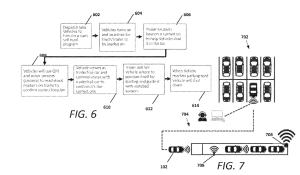Disclaimer: This blog was created for informational purposes only and does not represent Foresight’s or the author’s opinion regarding the validity, quality or enforceability of any particular patent covered in this blog. Foresight is not a law firm and no portion of the information contained in this blog was intended to serve as legal opinion.
One of the most memorable scenes from the HBO cult show “Silicon Valley” has a character named Jared summon an autonomous car which, in a twisted turn of events, had its route hijacked by its operator who rerouted it into a container ship, leading poor Jared to find himself unable to break free and finally emerge in the middle of the ocean surrounded by containers and robots! This week we are looking at a patent held by Ford Global Technologies carrying the patent number 11,858,498 and titled Autonomous Vehicle Loading with Smart Transportation Platforms, which could have prevented the situation that Jared found himself in. Ford Global Technologies operates as a subsidiary of Ford Motor Company and owns, manages, and commercializes patents and copyrights for Ford Motors. This patent was selected because it highlights a feature of autonomous operations that many people likely overlook, the benefit and cost savings such features can bring to the automotive manufacturer as opposed to the purchaser. Moreover, it highlights the potential revenue generation potential that intellectual property can bring to a patent holder.
Ford Global Technologies’ patent is focused on an application of self-driving that has been featured by other automotive companies, such as “Smart Summon” by Tesla, where the owner can activate this function and have their vehicle drive itself to your location, or a target destination, autonomously. These features have been marketed as a convenience tool to help move your vehicle out of a tight parking spot, through puddles, or to bring your vehicle closer to you while you are carrying packages. However, based on the details contained in the Ford patent, if these features are used by the manufacturer, it is possible to increase the speed of transporting vehicles as well as increase the safety and efficiency of a process that nearly all vehicles go through prior to arriving at the dealership. As seen in the image below, the concept behind this patent is relatively straightforward, by using autonomous driving to load vehicles onto transportation platforms, no longer is there a need for human drivers to move vehicles one-by-one onto the platform.
The patent itself describes the problem that this patent is seeking to solve; namely, the logistical hurdles inherent with loading and unloading vehicles at the scale and throughput required of a major automotive manufacturing company. The logistical hurdles mentioned in the patent specification include damage due to accidents or carelessness when loading and unloading vehicles on transportation platforms such as rail cars, shipping containers and trailers. Additionally, the description notes that this process of loading and unloading vehicles that are being shipped from manufacturers to dealerships or customers requires significantly manpower and time. According to information published on Ford’s website, the company assembled more than 1.8 million vehicles in the US in 2022 and every one of these vehicles need to be transported to a dealership or customer and this process currently involves an employee of physically sitting in each vehicle to load and another person responsible for the unloading process at the point of destination.
The patent is targeting this time, manpower and cost of damage issue by leveraging current and future autonomous features. The embodiments described in the patents do not require autonomy of this process. One example found in the patent requires a driver to be present to select the vehicle to be loaded and then has the option of activating a self-loading system found on the infotainment system and then the driver acts in a supervisory role, having that ability to take control of the vehicle if needed. However, the real benefits to Ford, and other manufacturers or transportation entities that may license the technology, is found in the fully autonomous embodiment. In this embodiment, a small number of employees act as coordinators who are able to select vehicles to activate a self-loading program. Once activated, the vehicle turns on, identifies the instructions related to the assigned transportation platform and order of loading and then the system will orchestrate the loading sequence of one or more vehicles. Within this embodiment, human involvement is limited to designing the specific program for loading on a given day and a confirmation process to ensure that the process is running smoothly. Such a process removes the requirement for a 1:1 ratio of human interactions per loaded vehicle and enables a small number of employees to act in a supervisory role. Not only does Ford benefit from the reduced manpower and time needed for loading, but also benefits from the precision driving that is expected from a vehicle once full autonomy is achieved. An additional benefit to Ford would be the ability to license this technology to its network of dealerships and transportation partners to increase efficiencies across the entire network while also having the option to license the technology to other automotive companies who have embraced full autonomous driving capabilities within their vehicles. So next time you summon an autonomous ride, you can rest assured that you will not end up like Jared!
Have you come across any interesting patents you would like us to feature in future blogs or did you invent a technology you would like featured? Please send us an email at media@foresightvaluation.com or call our office at (650) 561-3374.



